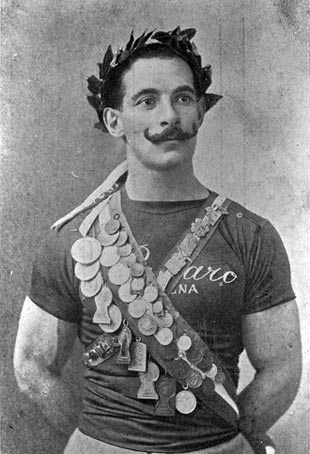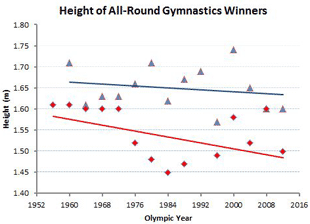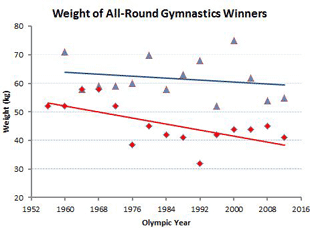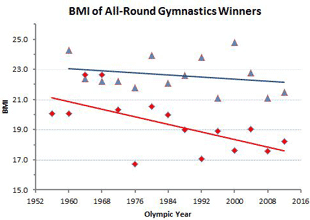The Olympic Games brings together the best gymnasts in the world. Studying the changes in anthropometric measurements of the Olympic all-around gymnastics champions can demonstrate how the size and shape of the athletes have changed over time.
 All-round winner from 1912: Alberto Braglia
All-round winner from 1912: Alberto BragliaGymnasts have generally always been small, as it gives an advantage of better balance and easier rotation in the air, though the diminutiveness of the female gymnasts in particular has been more pronounced in recent times. The following quote highlights the turning point in the 1970s (Nauright and Parrish, 2012).
"Until the 1970s, Olympic [female] gymnastics medalists were typically 22-23 years old, 5 feet 3 inches tall, and 120 pounds. However, at the Montreal games in 1976, changing body types were evident on the competition floor; the average ages and dimensions of winners were shrinking: The typical age was 16.6 years; the height was 5 feet; and weight was 101 pounds. The trend toward younger and smaller athletes, prefigured by Ludmilla Tourischeva in 1968, became the norm during the 1970s."
The lower average age of competitors plays a part in their decreasing body sizes, though changes in the age rules have tried to limit this. In the 1970s the average age of Olympic gymnastics competitors began to gradually decrease, with teenage athletes the norm. In response to the increasing demands of the sport, the age restriction for senior-level competitions was increased in 1980 from 14 to 15 years, then raised again to the current level in 1997 from 15 to 16.
An analysis of all the female US Olympic gymnastics teams by Sands et al. (2012), found that when using linear correlations height, mass, age, BMI have been declining since 1956. This is similar to the result you will see below in the analysis of just the Olympic champions. However, against this trend, second-order polynomial curve fits indicated that in the last four Olympic Games the gymnastics have been getting larger. Maybe we are seeing changes in the ideal body shape required to be a successful gymnast.
Anthropometric Measures of Olympic Champions
Here are tables of the height, weight and body mass index (BMI) of the male and female Olympic Games all-around gymnastics champions. Unfortunately, data has not been found for many of the early Olympians. The table data is presented graphically below, clearly showing how these measures have changed over time (years 1956+). Generally, the winning gymnasts have become shorter, lighter and with a lower BMI, with the changes more pronounced in the female gymnasts.
Male all-around champions
| Year | Winner | Height | Weight | BMI |
|---|---|---|---|---|
| 1900 | Gustave Sandras (France) | |||
| 1904 | Julius Lenhart (USA) | 1.68 m / 5 ft 6 in | ||
| 1908 | Alberto Braglia (Italy) | |||
| 1912 | Alberto Braglia (Italy) | |||
| 1920 | Giorgio Zampori (Italy) | |||
| 1924 | Leon Štukelj (Yugoslavia) | |||
| 1928 | Georges Miez (Switzerland) | |||
| 1932 | Romeo Neri (Italy) | 1.67 m / 5 ft 5.5 in | ||
| 1936 | Alfred Schwarzmann (Germany) | |||
| 1948 | Veikko Huhtanen (Finland) | 1.76 m / 5 ft 9 in | ||
| 1952 | Viktor Chukarin (Soviet Union) | |||
| 1956 | Viktor Chukarin (Soviet Union) | |||
| 1960 | Boris Shakhlin (Soviet Union) | 1.71 m / 5 ft 7 in | 71 kg / 157 lb | 24.3 |
| 1964 | Yukio Endo (Japan) | 1.61 m / 5 ft 3 in | 58 kg / 128 lb | 22.4 |
| 1968 | Sawao Kato (Japan) | 1.63 m / 5 ft 4 in | 59 kg / 130 lb | 22.2 |
| 1972 | Sawao Kato (Japan) | 1.63 m / 5 ft 4 in | 59 kg / 130 lb | 22.2 |
| 1976 | Nikolai Andrianov (Soviet Union) | 1.66 m / 5 ft 5 in | 60 kg / 132 lb | 21.8 |
| 1980 | Alexander Dityatin (Soviet Union) | 1.71 m / 5 ft 7 in | 70 kg / 154 lb | 23.9 |
| 1984 | Kōji Gushiken (Japan) | 1.62 m / 5 ft 3.5 in | 58 kg / 128 lb | 22.1 |
| 1988 | Vladimir Artemov (Soviet Union) | 1.67 m / 5 ft 5.5 in | 63 kg / 139 lb | 22.6 |
| 1992 | Vitaly Scherbo (Unified Team) | 1.69 m / 5 ft 7 in | 68 kg / 150 lb | 23.8 |
| 1996 | Li Xiaoshuang (China) | 1.57 m / 5 ft 1.5 in | 52 kg / 115 lb | 21.1 |
| 2000 | Alexei Nemov (Russia) | 1.74 m / 5 ft 8.5 in | 75 kg / 165 lb | 24.8 |
| 2004 | Paul Hamm (USA) | 1.65 m / 5 ft 4.5 in | 62 kg / 137 lb | 22.8 |
| 2008 | Yang Wei (China) | 1.60 m / 5 ft 2.5 in | 54 kg / 119 lb | 21.1 |
| 2012 | Kōhei Uchimura (Japan) | 1.60 m / 5 ft 2.5 in | 55 kg / 121 lb | 21.5 |
| 2016 | Kohei Uchimura (Japan) | 1.62 m / 5 ft 3.5 in | 52 kg / 115 lb | 19.8 |
| 2021 | Daiki Hashimoto (Japan) | 1.64 m / 5 ft 5 in | 57 kg / 126 lb | 21.2 |
| 2024 | Shinnosuke Oka(Japan) | NA |
Female all-around champions
| Year | Winner | Height | Weight | BMI |
|---|---|---|---|---|
| 1952 | Maria Gorokhovskaya (Soviet Union) | |||
| 1956 | Larisa Latynina (Soviet Union) | 1.61 m / 5 ft 3 in | 52 kg / 115 lb | 20.1 |
| 1960 | Larisa Latynina (Soviet Union) | 1.61 m / 5 ft 3 in | 52 kg / 115 lb | 20.1 |
| 1964 | Věra Čáslavská (Czechoslovakia) | 1.60 m / 5 ft 2.5 in | 58 kg / 128 lb | 22.7 |
| 1968 | Věra Čáslavská (Czechoslovakia) | 1.60 m / 5 ft 2.5 in | 58 kg / 128 lb | 22.7 |
| 1972 | Ludmilla Tourischeva (Soviet Union) | 1.60 m / 5 ft 2.5 in | 52 kg / 115 lb | 20.3 |
| 1976 | Nadia Comăneci (Romania) | 1.52 m / 5 ft 0 in | 39 kg / 85 lb | 16.7 |
| 1980 | Yelena Davydova (Soviet Union) | 1.48 m / 4 ft 10 in | 45 kg / 99 lb | 20.5 |
| 1984 | Mary Lou Retton (USA) | 1.45 m / 4 ft 9 in | 42 kg / 93 lb | 20.0 |
| 1988 | Yelena Shushunova (Soviet Union) | 1.47 m / 4 ft 10 in | 41 kg / 90 lb | 19.0 |
| 1992 | Tatiana Gutsu (Unified Team) | 1.37 m / 4 ft 6 in | 32 kg / 70 lb | 17.0 |
| 1996 | Lilia Podkopayeva (Ukraine) | 1.49 m / 4 ft 11 in | 42 kg / 93 lb | 18.9 |
| 2000 | Simona Amânar (Romania) | 1.58 m / 5 ft 2 in | 44 kg / 97 lb | 17.6 |
| 2004 | Carly Patterson (USA) | 1.52 m / 4 ft 11.5 in | 44 kg / 97 lb | 19.0 |
| 2008 | Nastia Liukin (USA) | 1.60 m / 5 ft 2.5 in | 45 kg / 99 lb | 17.6 |
| 2012 | Gabby Douglas (USA) | 1.50 m / 4 ft 11 in | 41 kg / 90 lb | 18.2 |
| 2016 | Simone Biles (USA) | 1.45 m / 4 ft 9 in | 47 kg / 104 lb | 22.4 |
| 2021 | Suni Lee (USA) | 1.52 m / 5 ft 0 in | 51kg / 112 lbs | 22.1 |
| 2024 | Simone Biles (USA) | 1.42 m / 4 ft 8 in * | 47 kg / 104 lb | 23.3 |
notes: * Simone Biles' height on Wikipedia was curiously reduced from 4 ft 9 in to 4 ft 8 in between 2016 and 2024. We have left each measurement as recorded at the time.
source: height and weight data was collected primarily from the Wikipedia profiles of each athlete, and when none was available, from the sports-reference.com website. Since 2012, data is from the official athlete database.
Height changes over time
The average heights of the Olympic all-round gymnastics champions has generally decreased in the data shown from 1956 until 2012. The decrease in height is more pronounced for the women (red) than the men (blue)

Weight changes over time
The body weights of the Olympic all-round gymnastics champions has generally decreased in the data shown from 1956 until 2012, in line with changes in height. The decrease in weight is more pronounced for the women (red) than the men (blue)

BMI changes over time
The BMI of the Olympic all-round gymnastics champions has also has generally decreased in the data shown from 1956 until 2012. The decrease in weight is more pronounced for the women (red) than the men (blue), with early champions having a BMI over 20, and recent winners from 17-19

Note: This analysis is for illustrative purposes only. The data was from many different sources, and may also not accurately represent their anthropometric measurements at the time of their competition.
References
- William A. Sands, Cindy Slater, Jeni R. McNeal, Steven Ross Murray, and Michael H. Stone (2012) Historical Trends in the Size of US Olympic Female Artistic Gymnasts. International Journal of Sports Physiology and Performance, 2012, 7, 350-356.
- John Nauright and Charles Parrish, (eds), 2012, Sports Around the World: History, Culture, and Practice.
Related Pages
- Details of the Olympic Games artistic gymnastics
- Anthropometry of Olympic Athletes
- List of Olympic Gymnastics All-Around Winners - Men and Women
- Sport Specific Anthropometry, including Gymnastics Anthropometry
- Athlete Body Size Changes Over Time
- About Artistic Gymnastics
- About BMI
- Science and the Olympics
- Olympics Anthropology Days


 Current Events
Current Events